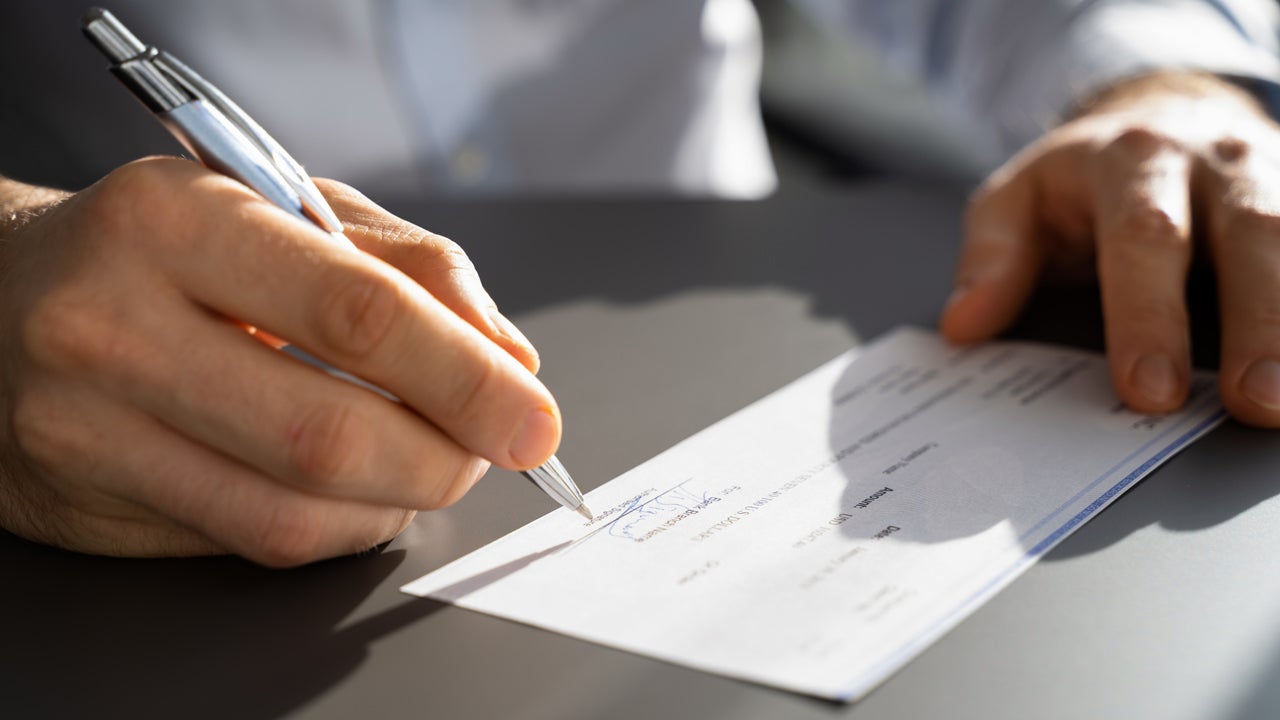What is a checking account?

Key takeaways
- Checking accounts are commonly used for paying bills, writing checks, making debit card purchases and ATM cash withdrawals.
- A checking account can also serve as a place to receive your payroll direct deposit as well as to send money digitally to friends and family.
- Checking accounts are often covered by federal deposit insurance. Most checking accounts don’t bear interest.
A checking account is a bank account that’s designed to be the hub of your financial life, and it’s easy to deposit money into these accounts and withdraw funds, as needed.
What is a checking account used for?
A checking account can help you manage your money. Here are some common uses for a checking account:
- Bill payment (online, automatic, or by check)
- Check writing (in-store, online, contactless)
- Debit card transactions
- Electronic funds transfer to savings or investment accounts
- Payroll direct deposit
- Withdrawing cash at an ATM
- Making wire transfers and person-to-person payments (e.g., Zelle, Venmo)
Unlike savings accounts, checking accounts don’t limit the number of transactions you can make or charge fees for excessive transactions.
Checking account features and services
Checking accounts have features that can help you manage daily transactions. Here are a few common features you’ll typically find:
Debit card access. A checking account provides a debit card linked to the account. This makes electronic purchases and ATM withdrawals possible.
Online and mobile banking. Many bank accounts allow account management through the internet or mobile apps. This way, customers can check balances, transfer money, pay bills and deposit checks.
Overdraft protection. Overdraft protection helps bridge the gap by covering transactions that exceed the account balance. This isn’t an automatic service. You have to opt in to this program because you might be on the hook for a fee if you do overdraft. Many banks allow you to link to another account to transfer funds to cover an overdraft transaction.
Direct deposit. The direct deposit feature allows account holders to electronically deposit income directly into the checking account. Some financial institutions allow early access to funds through direct deposit.
Check writing. Although checks aren’t as popular as they used to be, many checking accounts still offer the ability to write physical checks.
Benefits of checking accounts
Checking accounts keep your money safe and accessible, and they make it easy to automate your money management.
Safety
Using a checking account debit card for purchases can be safer than carrying around large amounts of cash, which can help protect your money should your wallet become lost or stolen.
If your checking account is with a federally insured bank or credit union, your money is safe, even if your bank fails, as long as your balance is within the established limits and guidelines. Through the Federal Deposit Insurance (FDIC) or National Credit Union Share Insurance Fund (NCUSIF), funds are insured up to $250,000 per depositor, per insured financial institution, per ownership category.
Ease of access
A checking account makes it easy to access your money using a debit or ATM card, checks and online payment features. It can be used for everything from retail purchases to rent or mortgage payment to automated bill payments.
If you need to pay your friends or family, many checking accounts feature a peer-to-peer transfer service, such as Zelle, that you can use from your smartphone or computer. You can also link your account to other services like Venmo to make quick transfers.
Automation
Checking accounts make it easy to automate money management. You can set up direct deposit so paychecks are automatically credited to your account, eliminating the need to manually deposit your funds each time you get paid.
You can also set up automatic payments so money is deducted to pay your credit card, utilities and other bills on their due dates.
Access to overdraft protection
Overdrafts can occur when you withdraw more money from your account than you actually have in it and your balance dips below zero. The overdraft fees the bank charges you to cover your payment can be expensive. Many checking accounts offer overdraft protection, which automatically transfers funds from your savings account or a line of credit when your checking account is overdrawn. Overdraft protection can allow your payment or debit to go through and if your bank has forgiving policies, help you avoid the associated fees, too.
Checking vs. savings accounts
A checking account is best for making day-to-day financial transactions, while a savings account is a good place for funds set aside for emergencies, or financial goals such as a vacation or a new car purchase. Here are some of the main differences.
| Feature | Checking account | Savings account |
| Debit card | Yes | Not usually |
| Check writing | Yes | No |
| Interest rate | Low or none | Higher (with the best accounts) |
| Minimum balance requirements | Varies | Varies |
| Typical use | Daily transactions | Saving money |
In general, savings and checking accounts vary in their:
- Primary use: A checking account is typically used for money you’ll spend, whereas a savings account holds money you’re holding onto.
- Interest: Many checking accounts earn no annual percentage yield (APY), while those that bear interest often pay a minimal rate or require you to jump through hoops to earn a higher one (such as making a certain number of debit card transactions per month). Savings accounts typically earn an APY, though the rate varies by bank.
- Limits on transfers: While a checking account allows for an unlimited number of transactions, savings accounts limit transfers to six a month in some cases. In April 2020, the Federal Reserve amended Regulation D to remove the six-transfer limit requirement but some banks still choose to impose this limit.
Common checking account fees
When shopping around for the right checking account, pay attention to what fees may be charged. While free checking accounts are widely available, many checking accounts do charge fees, and some common ones include:
- Monthly maintenance fees: Not all checking accounts have these, and those that do may waive them when you meet certain requirements, such as signing up for direct deposit, maintaining a minimum balance or making a set number of debit-card purchases.
- ATM fees: Your bank may provide its own ATMs or give you access to a network of fee-free ATMs like Allpoint or MoneyPass. Using ATMs outside the network could result in fees from your bank as well as the ATM owner. Some banks reimburse up to a set amount of these fees each month, and you can also avoid them by getting cash back from a debit card purchase instead of using an ATM.
- Overdraft fees: Withdrawing more money than you have in your checking account can result in an overdraft fee if you enroll in overdraft protection. The average overdraft fee is a hefty $27.08, according to a 2024 Bankrate study. You can avoid these automatic fees by opting out of them with your bank, whereby the bank will return payments as unpaid that overdraw the account. You can also choose to enroll in overdraft protection if your bank offers any free ways to use it – such as linking a savings account to cover transactions. Or choose a bank that doesn’t charge overdraft fees, such as Capital One or Ally Bank.
Types of checking accounts
Here’s a rundown of some of the different types of checking accounts:
Traditional checking
Best for: Everyday banking needs
These accounts normally provide checks, a debit or ATM card and online bill payment access. Some charge maintenance fees, which are often waivable by meeting set requirements. Overdraft protection may be provided to cover payments that would otherwise have overdrawn the account.
Interest checking
Best for: Earning interest and everyday banking needs
Interest-bearing checking accounts often allow you to earn an APY in exchange for having your paycheck directly deposited or making a minimum number of monthly debit card transactions (though some banks, like Ally, pay a little interest without any restrictions). The APYs earned by many interest checking accounts, however, are only a fraction of what the best high-yield savings accounts earn.
Student checking accounts
Best for: Students in their teens or 20s
Often available to students in their teens or 20s, the best student checking accounts offer perks to anyone learning to manage their money, such as overdraft forgiveness, free checks, no maintenance fees or the reimbursement of ATM fees.
Senior checking
Best for: Individuals 55 and older looking for banking perks
Senior checking accounts offer benefits attractive to those age 55 or older, such as free checks and money orders, as well as fees that are easy to waive. If you’re looking for these perks, however, you might find them in many traditional checking accounts as well.
Second-chance checking
Best for: Those denied traditional checking accounts due to past banking issues
Anyone who has been denied a traditional checking account based on a history of excessive overdrafts or unpaid overdrawn balances might consider a second-chance checking account. These accounts often impose certain restrictions and fees, yet some allow customers to move to a traditional checking account after handling the second-chance account responsibly for a defined period.
You can find second-chance accounts at banks like Wells Fargo and Varo.
How does a checking account work?
A checking account allows frequent access to funds and is used for daily transactions, like purchases made with a debit card or electronic transfers. These accounts often permit unlimited transactions, making them a good choice for bill payments and purchases.
Checking accounts don’t usually offer high interest rates on balances. Instead, these accounts tend to focus on convenience and liquidity. They may come with monthly fees, although many banks offer ways to waive these charges based on factors such as account balance, for example.
How to choose a checking account
There are various factors to consider when shopping around for a checking account:
- Monthly maintenance fees
-
These fees can eat away at your balance over time, but it’s not hard to find a free checking account that doesn’t charge these fees. Those that charge service fees often offer ways to avoid them, such as maintaining a set minimum balance in the account.
See more: Best checking accounts
- ATM availability
-
The average out-of-network ATM fee is $4.77, Bankrate’s latest ATM Study found. This includes the average surcharge from the ATM’s owner as well as one from a consumer’s own bank. To avoid such fees, choose a bank that offers plenty of its own ATMs, one that belongs to a large ATM network or one that reimburses you ATM fees.
- Digital banking
-
If you prefer to do most or all of your banking online, it can pay to find a checking account at a bank that offers mobile check deposit, online bill pay and a peer-to-peer payment option.
Compare: Best banks and credit unions for mobile banking
- Branch availability
-
Those who prefer in-person banking should open a checking account at a bank that maintains nearby branches.
How to open a checking account
- Once you’ve shopped around and chosen a checking account, you can start the process of filling out an application, which typically involves providing some personal information and government-issued ID, like a driver’s license. If you’re funding your new account from your old checking account, you’ll also need both the routing number and account number for your old account. This information will enable your new bank to transfer funds from your old account to the new one. If you’re opening an account in person, you might be able to make your initial deposit with a check or cash.
- After your account is open and ready to use, take the time to understand its features. Sign up for online banking, download your bank’s app and set up automated payments and direct deposit.
- Review the latest statement from your old bank to ensure you haven’t missed transferring any automated payments from the old account to the new one. Also, update your employer’s payroll manager with your new account information to ensure your direct payroll deposit goes to the correct account. Human resources can usually help make that change.
- Once a couple of months have passed with no automatic bill payments from your old account, you should be ready to close it and continue on with only the new checking account. If your old account charges a monthly fee though, make sure you continue to meet the requirements to waive it while you wait to close the account.
Bottom line
Be sure to find the right checking account for you, whether it’s one that has a robust ATM network, charges no fees or offers the ability to earn interest. Once you find the account that suits your needs, you’ll appreciate how a checking account enables you to handle your day-to-day finances.










